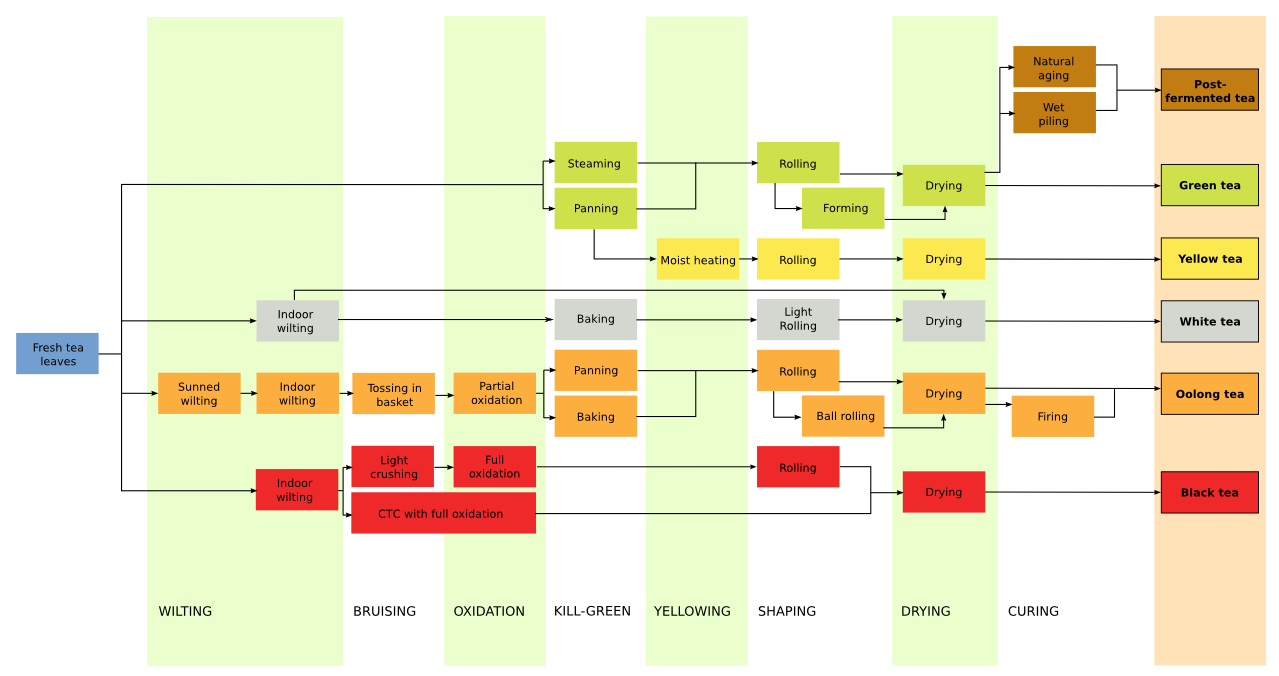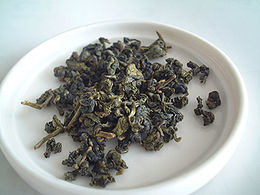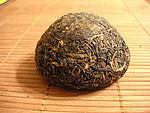Is Oolong tea a kind of green tea? Is Long Jing a kind of tea or a brand? Which one does what for you? These questions have been on my brain longer than my stay here in China (since 2005). After all, tea is the most consumed drink in the world after water. There are certainly more than a few reasons for that! After discussing the specifics with Chinese friends, tea aficionados, and tea shop owners, I can safely say that the mystery around tea is not so complicated after all. Let’s start generally and get more specific as we go along!
 One Plant: All (leaf) tea comes from the same species of plant. Just like apples all come from apple trees… Varieties exist among all species and those varieties include: Green, Oolong, Black, White, Yellow,and Pu’er. Processing and growing techniques are other ways that teas get their distinctive colors, flavors, and characteristics. For specifics on processing, check out the image on the right. The following disambiguations are listed from lighter to darker tea varieties.
One Plant: All (leaf) tea comes from the same species of plant. Just like apples all come from apple trees… Varieties exist among all species and those varieties include: Green, Oolong, Black, White, Yellow,and Pu’er. Processing and growing techniques are other ways that teas get their distinctive colors, flavors, and characteristics. For specifics on processing, check out the image on the right. The following disambiguations are listed from lighter to darker tea varieties.
Green Tea- A highly popular tea variety in Asia and is produced mainly in China. It contains caffeine and often more so than coffee. Drinking green tea is associated with reduced heart disease and reduces cardiovascular risk factors. It also has some affect on reducing blood pressure, body fat, and cholesterol, but it certainly isn’t a magic bullet if you have these conditions. In 2009, it was cited that women who add more mushrooms to their diet and drink green tea regularly can seriously reduce occurrences of breast cancer[*]. It may also play a role in eye diseases, including glaucoma.
I find that green tea is the most delicious tea option; especially the special sub-variety called “Long Tan” (Henan Province) which can cost around $50/100g. The most famous brand of Green Tea is “Long Jing” (Zhejiang Province).
White Tea- This tea is allowed to wilt while being just slightly oxidized. It is made from younger leaves (and buds) than other teas, but contains about the same caffeine. Health benefits of White tea are similar to those previously mentioned, but perhaps due to lack of processing, contains more anti-viral and anti-bacterial qualities than green tea.[*]
Yellow Tea- A less common tea which is only different based on the slower drying method employed to produce it.
Oolong Tea- Between Green and Black tea is Oolong tea which is only slightly oxidized (fermentation stops when leaves slightly change color). This is commonly found in Chinese Restaurants (especially those of Southern China, Cantonese style). I would say that “Tie Guan Yin” is perhaps the most famous sub-variety consumed in China. Many Oolong sub-varities can be found growing in Wuyi Cliff (Mtns.) in Fujian province, although other tea varieties are grown at Wuyi Mountain. Health benefits are practically the same as standard green teas, but the caffeine is slightly less.
Black Tea- Or “Crimson Tea” is more oxidized than Green, Oolong, and White tea. It’s production is led by companies like Lipton and Twinings, and is more popular in Western countries. As with less oxidized varieties, Black tea has similar health benefits. I find that the flavor of this tea causes me to add sugar and other flavorings. To do so makes the tea no better for you than drinking coffee in the morning. It has probably remained popular in the West due to its longer shelf life.
Pu’er Tea- The best known post-fermented tea is Pu’er [pronounced "Pooh-R], which is even darker than Black tea. I find it to be the coffee of Tea, based purely on its color after steeping. It has become classified by a system similar to wine, which uses regions and year of production to judge quality. This tea is highly popular in Guangdong province after meals, but it is famously grown in Yunnan province. It is commonly said to help with digestion and weight loss. It isn’t a weight loss plan by itself, however, it aides cholesterol reduction and can speeds up metabolism. Recent studies tell about its “antimutagenic and antimicrobial” abilities.[*]
Remember: I’ve sourced some of the claims above, but a lot of medicinal food properties were provided by word of mouth. As a form of Chinese medicine for over 4000 years, (leaf) Tea is a long-standing pillar in the Asian lifestyle, which shouldn’t take a scientist to convince you of its very real benefits to your health.





 Custom Search
Custom Search
Pingback: Medicinal Use of Tea | Asian Living.me()